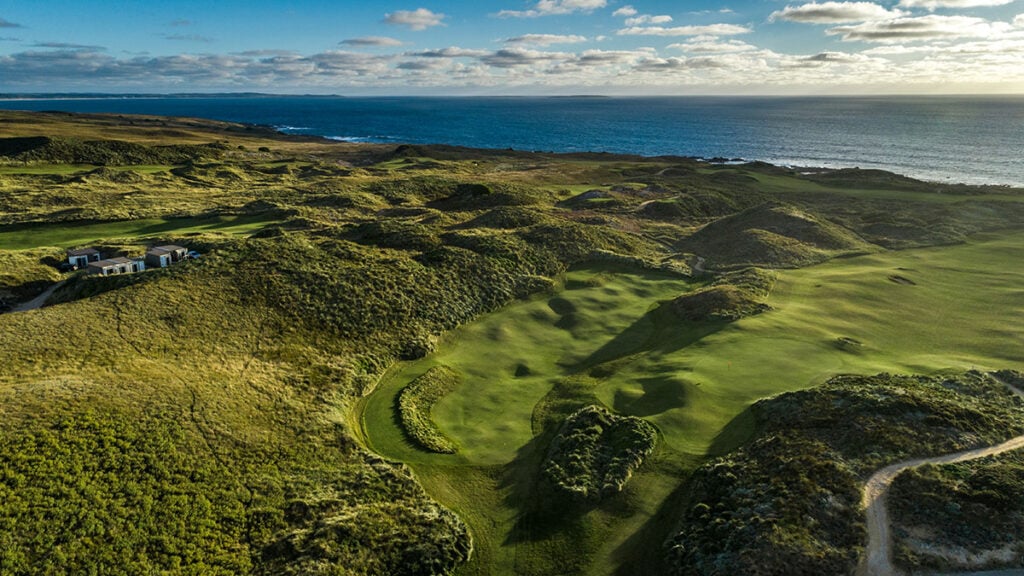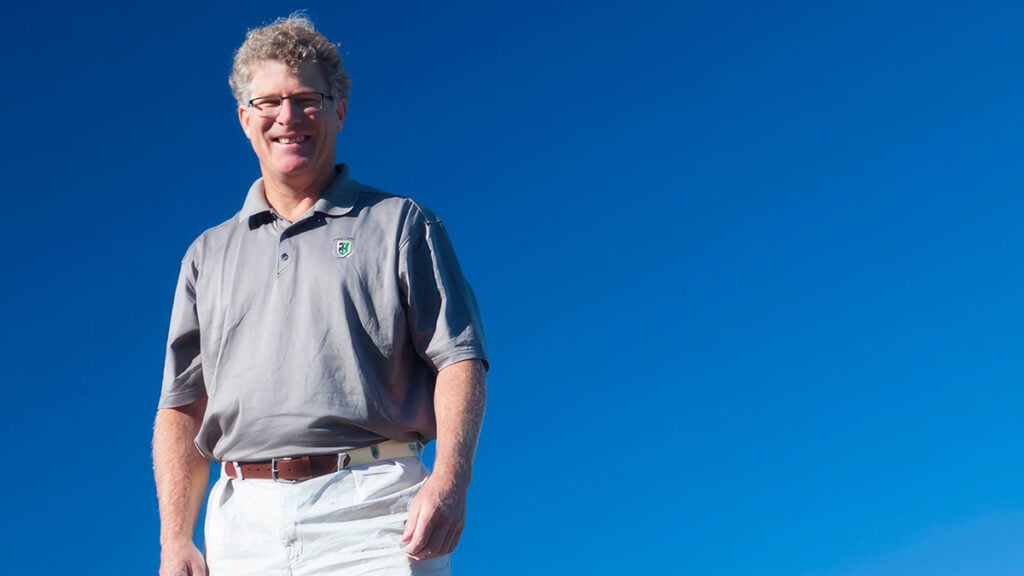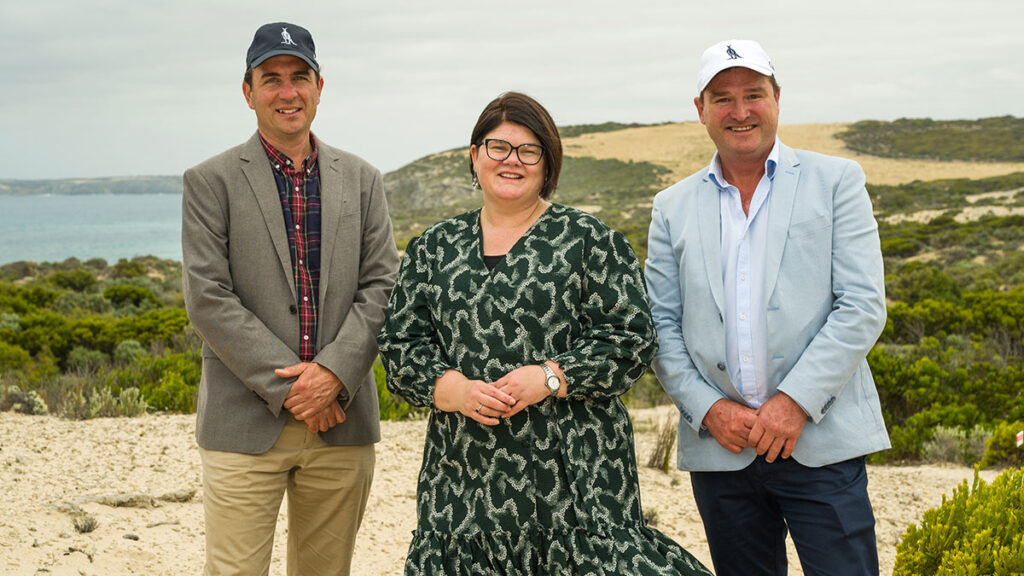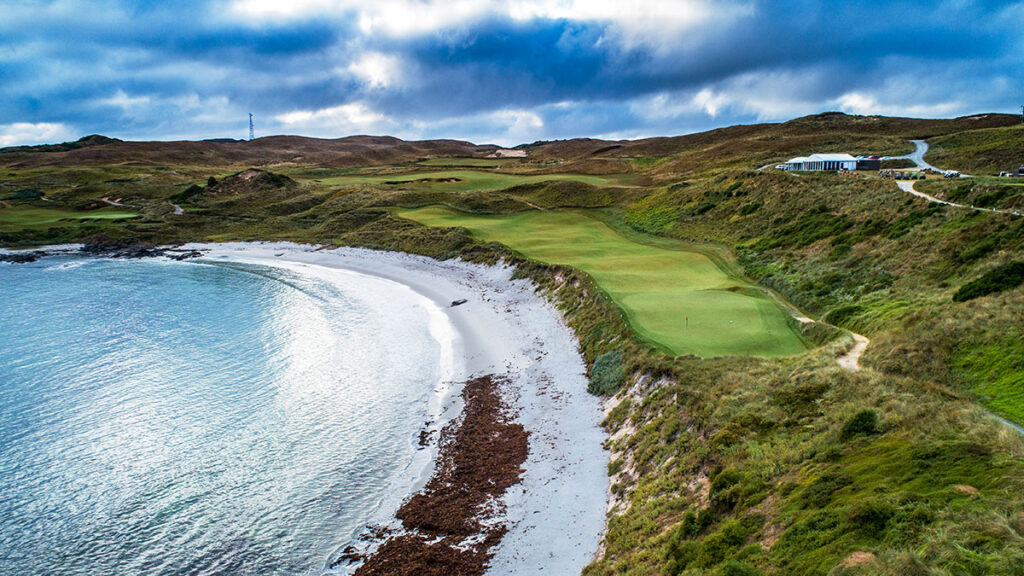It’s one of the most spectacular courses in the world yet confusion reigns over who actually designed it. Cape Wickham on Tasmania’s King Island is at the centre of a dispute between American Mike DeVries and Australian Darius Oliver. To solve the mystery, we asked Duncan Andrews, the man who funded the entire construction of Cape Wickham, to set the record straight.
Course Photography by Nick Wall
The opening of Cape Wickham Golf Links in 2015 heralded a new dawn in course construction. The spectacular coastal layout built on the foreshore of Tasmania’s King Island has influenced the way we appreciate golf.
Wickham won instant approval with its inaugural ranking at No.3 on Australia’s Top 100 Golf Courses. International acclaim followed when it was ranked No.24 on the World’s 100 Greatest Golf Courses by our sister publication, Golf Digest (USA).
The recognition was a wonderful acknowledgment for the two men credited with Wickham’s design: American Mike DeVries and Australian Darius Oliver. DeVries was a rising star in golf-course architecture circles. Victoria’s Oliver was a noted architecture buff and author of the Planet Golf series of books.
Controversy surrounding Wickham arose in 2021 when two American publications – Golf Magazine and Golfweek – chose to credit DeVries as the sole designer. DeVries’ design company (Clayton, DeVries & Pont) appeared more than happy to perpetuate this narrative with multiple posts on social media failing to acknowledge it as a co-design. However, it rankled Oliver that his substantive role at Wickham was being wiped from history. To add fuel to the fire, Australian professional Mike Clayton sided with his American counterpart with whom he had entered into an architectural partnership (CDP).
To coincide with this issue’s publication of Australia’s Top 100 Golf Courses, we sought to learn the truth about who really designed Cape Wickham Golf Links. And who better to ask than the man who funded the entire construction of Wickham: Duncan Andrews [inset].
The 75-year-old made his name by founding the capital services company Australian Ratings, which later became Standard & Poor’s Australia. In later life he has become known as a golf-course developer, outlaying more than $35 million of his own money in three
major projects.
It was Andrews’ passion that led to the redevelopment of The Dunes on Victoria’s Mornington Peninsula in the early 1990s. He commissioned Tony Cashmore to redesign the layout, which became the catalyst for the renaissance of links golf across Australia. In the late 1990s, Andrews invested into a 36-hole residential development at 13th Beach on Victoria’s Bellarine Peninsula where layouts by Cashmore and Nick Faldo are the cornerstone for one of the best golf communities in Australia.
But his pièce de résistance is Cape Wickham on King Island that has redefined Australian golf. Incidentally, it would be remiss to omit the role played by Programmed Turnpoint, the company founded by Andrew Purchase that was responsible for all the construction, shaping and landscaping carried out at Wickham.
As for the controversy surrounding DeVries and Oliver, Australian Golf Digest sought an interview with Duncan Andrews to set the record straight about how Wickham came to fruition: from site identification, selection of architect, routing and design of individual holes.

Australian Golf Digest: We’re keen to set the record straight about what actually happened with the design of Cape Wickham Golf Links. Just establish that you funded the entire construction.
Duncan Andrews: A brief point of history. A guy called Andrew Purchase, who owned the golf-construction company Programmed Turnpoint, found this land on the northern tip of King Island. He thought it was pretty good. And he bought it. He talked to Darius Oliver about it and Darius looked at it.
Darius rang me and he must have rung me on and off for six months, saying: “Come and have a look at it. It’s the best land I’ve ever seen in the world…” Darius has a pretty good view of what’s good golf-course land and what’s not. Eventually I relented.
We got a helicopter down on a beautiful sunny day, probably it might have been late February 2013. We
landed on what’s now the 18th fairway and within about 10 or 15 minutes I was sold. It was as good a parcel of land as you would ever see for a golf course. I went back to Victoria and sort of lay awake at night for about two weeks thinking, Will I or won’t I? It’s a pretty odd place to build a golf course. In the end I decided, Bugger it, I will do it. This is probably the one chance in your life you’ve got of building something that will be in the World’s Top 100.
So I went to Andrew Purchase and said, “What do you want to do with this?” And he said, “I want to sell it to you.” We agreed on a price in about 10 minutes. Literally. Then the hard work started.

What was the selection process for choosing a course architect to design Cape Wickham?
So I put a team together of Andrew Purchase for construction, an irrigation guy and we also needed a superintendent to manage the grass growing. Darius was helping me. Ten years ago Darius was primarily a golf-course author with an obsession for golf-course design plus an almost encyclopaedic knowledge of various golf holes around the world. He and I felt we needed a course designer from America – and this is the critical point – I needed a known name in the US because world rankings are very New York-centric. Whether you like it or not, if you don’t have an American designer, you’re starting behind the eight-ball to get world recognition.
We had a look around and it was decided this younger guy called Mike DeVries was potentially a bit of an up-and-comer. We talked to him and he desperately wanted to do the job – because naturally an architect wants to work on wonderful land.
Concurrently, I was talking to Bill Coore [of Coore Crenshaw]. I think I made a terrible error. I sat for possibly two hours with Bill on the deck at my beach house in Flinders. I really enjoyed his company and liked him very much. We talked about what I wanted to do. Then I said to Bill, “How much would you charge for this?”
The fee was substantial.
I went “OK. Now Bill, I’m going to want to have an input if we’re going to spend that sort of money with you.” And there was silence for about two minutes and then he said, “No.”
Then I said, “Bill, that’s impossible. I cannot spend that sort of money with you and not want to talk to you, and sort of agree with you about what you’re doing, and why you’re doing it. And query you.”
And he said, “Well, it’s going to be my course.”
But I realised later – because he’s a really lovely guy – he was just making a position statement. If I had proven that I knew a bit about what I was talking about and worth listening to, we would’ve got on fine. I regret it because he is a great architect.

Who was responsible for the routing of Cape Wickham?
So we ended up with Mike DeVries. Mike came out to Australia from Michigan. He spent a month there on King Island looking at potential layouts. The problem with laying out an 18-hole course at Wickham was that there were at least 100 terrific golf holes. And probably 10 different routings for the golf course you could have. At least 10, maybe more.
This is the delicious thing about a course like this: there’s no right answer. It’s like a jigsaw puzzle. If you put in that hole because it’s gorgeous, you can’t fit in the other equally gorgeous hole. We wanted to make a course that was walkable and one hole that fed into another. We weren’t going to have 500-metre walks between tees and greens.
Anyway, Mike put together a routing that was good, but it changed considerably in the end with input from Darius and me… There’s always in these things, an element of disagreement. Routing a course, architects would say it’s their skill, but I don’t entirely agree with that. Darius and I are as competent for routing a golf course as somebody else. Once you’ve set your rules – let’s say, for example, where is the first hole going to be or will there be returning nines – it becomes easier. Cape Wickham was hard because there were so many choices and that meant compromises all the way along.
You mentioned Andrew Purchase was responsible for identifying the site on which Cape Wickham was built. Could you expand upon that?
Andrew Purchase from Programmed Turnpoint was the guy that found the land and bought it. I bought it from him. I paid $2 million for it, subject to a few conditions.
Andrew didn’t have enough land in my opinion. We needed to get some extra land from the neighbouring farmer. And we had to get approvals from the Tasmanian Government so we could put about eight greens on the foreshore, right on the coast. Cape Wickham is remote, and it seemed unlikely we could get enough visiting golfers unless we did something genuinely different. And that meant greens right on the water – right on Bass Strait. That’s why it’s so rare and different.
So $2 million was subject to getting an extra 100 acres and getting the approval from the Tassie government. That was a bit of a pain in the neck, but we got there in the end.
How much did you pay for that extra 100 acres?
Andrew Purchase had to pay for that. That was part of the deal. The farmer told him he could have it for a song because it was in sand dunes. When he got wind that Andrew needed it, then he held him to ransom. But that’s another matter. I won’t tell you what occurred, but it was pretty outrageous.
The battle with the Tasmanian Government took maybe six to nine months. It wasn’t the government, it was the [Department of Natural Resources and Environment Tasmania] who didn’t want us to build a golf course on the site and came up with these bizarre statements. For example, if we had any lighting on the course it had to point to the ground in case the mutton birds flew into buildings. It was such errant nonsense. The biggest lighthouse in the southern hemisphere was on our boundary. And there was no evidence of dead mutton birds on the ground around the lighthouse. This was the irrational level of these people. They did whatever suited them to try to stop it. They weren’t interested in golf or any development whatever. The Tasmanian Government wanted the course, but their department was running their own set of rules.
We got there in the end. But not before I threatened and, in fact, started taking machinery off King Island. I actually transported some machinery back to Victoria, which made people realise I was absolutely serious: “You either do this or you don’t.” Anyway, we got what we needed… It’s very hard to deal with people when they have the authority and they’re zealots. I can say that now because I’m not involved [anymore with Cape Wickham Links].
Who was responsible for the routing of Cape Wickham? Mike DeVries or Darius Oliver?
I get asked that question a lot of times. I’ll go 40-40-20 [percent]. I think I was about 20.
Who was responsible for designing the individual holes at Cape Wickham – the tees, fairways, greens and bunkers?
It’s pretty simple. Mike DeVries did basically the first three, overall, maybe four holes. There were differences with Mike and the construction crew, and with Mike and myself. In the end I said, “Mike, here’s your fee in full. We’re going to leave it now to Darius. You can stay involved but more at a distance.”
He was very strong-minded. I guess, so am I. But you’ve got to compromise on stuff. He wasn’t very good at compromising… Mike was building a course for Mike and for scratch golfers. I was building a course for me and all golfers – scratch and 25-markers. It’s harder to do, by the way. Much harder. You’ve got to make a course playable for the higher markers. Because after all, they’re your bread and butter. They’re the ones who make it work commercially.
I’ll give you a good example. His view was: “This course is going to be too good to have golf carts on it.” And I said, “Well, it’s going to be good, but it will have golf carts.” And we had a total impasse over it.
The bulk of people who come to Cape Wickham are going to be over age 50 and they’ve got the resources to come down here. Knowing what golfers are like – blokes going away on a golf holiday – after the first day they’ve had a big night and before long they want a cart. That’s just the reality. And if you didn’t have carts, I think you hurt your market. You could say probably fewer people would be able to enjoy it.
A path for a golf cart is not a big deal. It can be done sensitively. I don’t think we’ve affected the image of it at all. But he really felt it had to be a totally traditional golf course. I simply disagreed.

Let’s talk about Darius Oliver’s role once he took over from Mike DeVries.
Well, he took over when we were building the par-3 17th green and going nowhere. Andrew Purchase would ring me and say, “This is hopeless. We’re not going anywhere. We’ve been on this green for 10 days and nothing’s happened.”
We just had to say to Darius: “You take it over.” Darius did, and I reckon he did the detailed design work for the guts of the course. I got involved in the routing. I don’t claim too much involvement in each green. That’s not something I’m very good at doing.
But Darius did it with no practical experience but with lots of support from Turnpoint. That’s what impressed me. He used to talk to me: “Why don’t we do this?” “How about we do this?” We’d talk about things. We spent hours, for example, working out what the 10th green would look like. And hours, frankly, on every hole. I don’t make a claim to be too involved in all of that stuff, beyond being a sounding board.
In 2021, Golf Magazine in the US came out and gave Mike DeVries sole design credit for Cape Wickham.
It was unfair to Darius, and it was untrue and misleading. I made an arrangement with Mike DeVries: “I’m going to pay you out in full on the condition that this will be a joint collaboration between you and Darius publicly.” And he agreed to that. He failed to honour the agreement.
So from a marketing perspective, how important was it to have a distinguished American golf-course architect involved with Cape Wickham?
My gut feeling was it was very important because this was a world-class site. I’m not suggesting Americans are better designers, merely that unless you had an American name involved, it was very hard for you to be rated appropriately.
For example, I used Tony Cashmore at The Dunes. I always thought it was given a bit of a rough deal. The same course by a famous name would have rated higher. It just influences the perspective of the so-called ‘raters’.

How much money did you put into Cape Wickham?
I’m not going to tell you that. I did it because I wanted to. Then I sold it.
I sold it because I just found operating on King Island inordinately difficult, or operating where we were on King Island – much more difficult than I had hoped it would be. It’s certainly expensive, but that wasn’t the problem. The problem was logistics. For example, if the chef called in sick, you had no one to cook the food. You had to dig up someone from a very small population base [approximately 1,500 residents live on King Island] to drive 40 kilometres to help you out. That is tough. Staffing was a bit of a nightmare. We ended up with staff mainly from Victoria. That was the problem: the staffing issues. Golfers were paying 150 bucks for a round of golf. For $150 they expect certain things to happen and that was easier said than done.
The fun had been building it. I’ve had my fun and we got a great rating. At one stage, Golf Digest [USA] had us 24 in the world… It was making a profit and that was also important.
It’s been reported you sold Wickham in 2017 for almost $16 million.
I sold it to a Vietnamese group. I never could quite work out why they bought it. And unfortunately, they didn’t want to spend any money on it… They appear to have run it on a shoestring. That’s the way they did it. I understand it’s now for sale.
It needs another course to give it critical mass. It needs a proper clubhouse. It needs good accommodation and it needs staff quarters. And it needs its own little runway and private airport. They’re all doable. But it’s all serious money.
Is there anything else you would like to say about the design controversy at Cape Wickham?
Well, it shouldn’t have happened. It needn’t have happened. And it’s disappointing. But the truth of the matter is they were both involved. But I think Darius played the more vital role. Not only was he the one that convinced me to come and buy it, he was the one that did the bulk of the detailed design work. He certainly also had a great deal of input into the course routing, which is pretty important.
The business in golf-course architecture is somewhat cut-throat. Everyone claims to be a disciple of Alister Mackenzie and da, da-da, da-da. There’s a lot of clichés. But in the end, I needed someone I can work with comfortably because – as an owner – I was very different to the average golf-course committee. Committees tend to, I think, hand over to the architect and wash their hands of what’s going on. Whereas I don’t work that way.
So DeVries had problems because he couldn’t just do what he wanted to do, he had to deal with me as well. I gave you that little story about the golf carts as being an example. In the end, it’s my money and I call the shots on important issues.
I expect consultation. No more than that. I don’t try to make any or all the decisions. But some things are – in my opinion – my call. Darius understood that. Probably Mike didn’t.
But why he couldn’t stick to the arrangement? I guess egos are egos.

You mentioned the future of Cape Wickham. I take it you would like to see someone come in with deep pockets and passion?
I’ve always felt that. I’ll say this – he won’t mind, I’m sure – Tom Doak came down, virtually begging me to build the second course. There’s great land north of the lighthouse. I said to Tom: “But why would you want to build a second course when you probably will rank second?”
And he said, “That’s why I want to do it. Because I think I can do something better. This land’s just as good.”
And he’s probably right.
When’s the best time to visit King Island for golf?
Making the trek to King Island is well worth the effort given Cape Wickham and Ocean Dunes are both ranked inside the first 15 of Australia’s Top 100 Golf Courses. But given the somewhat fickle nature of weather off Bass Strait, it’s important to time the visit for that bucket-list experience.
Cape Wickham developer and former owner Duncan Andrews selects February and March as the ideal time to visit because the weather is most conducive to golf: “I would say November through to Easter, roughly. You can go into May. November through May, and within that February and March.
“If I did it again, I know what I’d do. I’d only open it for six months of the year because in the winter months it just gets a bit too windy. Too many days when it’s not pleasant enough.
“There are plenty of courses around the world that are only open for part of the year. Golfers would simply have to adjust their schedule to do it. It’s a bit like going snow skiing. You can’t go to Perisher or Mount Buller when it suits you. It’s when you get a window.”
The 18-hole green fee at Wickham is $225 ($180 in low season), however visitors can play unlimited golf for $275 ($220). Cape Wickham offers on-site accommodation in 16 villa-style rooms. The standard rate for a king or twin room is $280.
For 18 holes at Ocean Dunes, the green fee is $205 ($160 low season) while for unlimited golf it’s $250 ($200). A variety of accommodation is available within and around the township of Currie.
Daily flights to King Island are from Burnie (Wynyard), Launceston, Hobart and Melbourne. Visit kingisland.org.au for more information.



